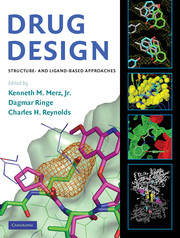Book contents
- Frontmatter
- Contents
- Contributors
- Preface
- DRUG DESIGN
- 1 Progress and issues for computationally guided lead discovery and optimization
- PART I STRUCTURAL BIOLOGY
- PART II COMPUTATIONAL CHEMISTRY METHODOLOGY
- 5 Free-energy calculations in structure-based drug design
- 6 Studies of drug resistance and the dynamic behavior of HIV-1 protease through molecular dynamics simulations
- 7 Docking: a domesday report
- 8 The role of quantum mechanics in structure-based drug design
- 9 Pharmacophore methods
- 10 QSAR in drug discovery
- 11 Predicting ADME properties in drug discovery
- PART III APPLICATIONS TO DRUG DISCOVERY
- Index
- References
6 - Studies of drug resistance and the dynamic behavior of HIV-1 protease through molecular dynamics simulations
from PART II - COMPUTATIONAL CHEMISTRY METHODOLOGY
Published online by Cambridge University Press: 06 July 2010
- Frontmatter
- Contents
- Contributors
- Preface
- DRUG DESIGN
- 1 Progress and issues for computationally guided lead discovery and optimization
- PART I STRUCTURAL BIOLOGY
- PART II COMPUTATIONAL CHEMISTRY METHODOLOGY
- 5 Free-energy calculations in structure-based drug design
- 6 Studies of drug resistance and the dynamic behavior of HIV-1 protease through molecular dynamics simulations
- 7 Docking: a domesday report
- 8 The role of quantum mechanics in structure-based drug design
- 9 Pharmacophore methods
- 10 QSAR in drug discovery
- 11 Predicting ADME properties in drug discovery
- PART III APPLICATIONS TO DRUG DISCOVERY
- Index
- References
Summary
INTRODUCTION
The human immunodeficiency virus (HIV) was first discovered to be the causative agent of acquired immunodeficiency syndrome (AIDS) in the early 1980s. There are currently three main avenues for preventing virus replication. The first is to block attachment of virus to the host cell surface by inhibitors of binding to coreceptors, such as CCR5. The second is to block the process of reverse transcription, an approach taken by a major class of anti-AIDS drugs, including, for example, azidothymidine (AZT), delavirdine, nevirapin, and so on. The third way is to disrupt the function of the viral protease (HIV-PR) that cleaves the gag-pol polyproteins required to assemble an active virus by binding an inhibitor to the center of the protease and freezing it closed; this is described in more detail in this review. At present there are eleven FDA-approved protease inhibitors in clinical use: Agenerase (amprenavir), Aptivus (tipranavir), Crixivan (indinavir), Fortovase (saquinavir soft gel), Invirase (saquinavir hard gel), Kaletra (lopinavir-ritronavir), Lexiva (Fosamprenavir), Norvir (ritonavir), Prezista (darunavir), Reyataz (atazanavir), and Viracept. All these inhibitors can lose most of their potency when confronted with mutations associated with drug resistance. Therefore, a thorough understanding of the mechanistic events associated with binding of HIV-PR substrates and inhibitors is pharmacologically critical for the design of novel inhibitors of the enzyme. There is evidence that flexibility of the enzyme plays an important role in inhibitor binding and resistance.
- Type
- Chapter
- Information
- Drug DesignStructure- and Ligand-Based Approaches, pp. 87 - 97Publisher: Cambridge University PressPrint publication year: 2010



